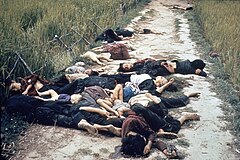
Back My Lai-menseslagting Afrikaans Massaker von My Lai ALS مذبحة ماي لاي Arabic Sonqmi qətliamı Azerbaijani Massaka vo My Lai BAR Масавае забойства ў Сангмі Byelorussian Клане в Ми Лай Bulgarian মি লাই হত্যাযজ্ঞ Bengali/Bangla Massacre de Mỹ Lai Catalan Masakr v My Lai Czech
| My Lai massacre Thảm sát Mỹ Lai | |
|---|---|
| Part of the Vietnam War | |
 Photo taken by U.S. Army photographer Ronald L. Haeberle in the aftermath of the massacre, showing mostly women and children dead on a road | |
| Location | Sơn Mỹ village, Sơn Tịnh district, Quảng Ngãi province, South Vietnam |
| Coordinates | 15°10′42″N 108°52′10″E / 15.17833°N 108.86944°E |
| Date | 16 March 1968 |
| Target | Mỹ Lai 4 and Mỹ Khe 4 hamlets |
Attack type | Massacre, war rape, torture |
| Deaths |
|
| Perpetrators | United States Army, specifically the C Company, 1st Battalion, 20th Infantry Regiment and B Company, 4th Battalion, 3rd Infantry Regiment, 23rd Infantry Division |
| Defenders | Hugh Thompson Jr., Lawrence Colburn, Glenn Andreotta |
| Convicted | William Calley |
| Convictions | Premeditated murder (22 counts), assault with intent to murder |
| Sentence | Life imprisonment; commuted to three years' house arrest by President Richard Nixon |
The My Lai massacre (/miː laɪ/ mee ly; Vietnamese: Thảm sát Mỹ Lai [tʰâːm ʂǎːt mǐˀ lāːj] ) was a war crime committed by the United States Army on 16 March 1968, involving the mass murder of unarmed civilians in Sơn Mỹ village, Quảng Ngãi province, South Vietnam, during the Vietnam War.[1] At least 347 and up to 504 civilians, almost all women, children, and elderly men, were murdered by U.S. soldiers from C Company, 1st Battalion, 20th Infantry Regiment, 11th Brigade and B Company, 4th Battalion, 3rd Infantry Regiment, 11th Brigade of the 23rd (Americal) Division (organized as part of Task Force Barker). Some of the women were gang-raped and their bodies mutilated, and some soldiers mutilated and raped children as young as 12.[2][3] The incident was the largest massacre of civilians by U.S. forces in the 20th century.[4]
On the morning of the massacre, C Company, commanded by Captain Ernest Medina, was sent into one of the village's hamlets (marked on maps as My Lai 4) expecting to engage the Viet Cong's Local Force 48th Battalion, which was not present. The killing began while the troops were searching the village for guerillas, and continued after they realized that no guerillas seemed to be present. Villagers were gathered together, held in the open, then murdered with automatic weapons, bayonets, and hand grenades; one large group of villagers was shot in an irrigation ditch. Soldiers also burned down homes and killed livestock. Warrant Officer Hugh Thompson Jr. and his helicopter crew are credited with attempting to stop the massacre. On the same day, B Company massacred an additional 60 to 155 people in the nearby hamlet of My Khe 4.
The massacre was originally reported as a battle against Viet Cong troops, and was covered up in initial investigations by the U.S. Army. The efforts of veteran Ronald Ridenhour and journalist Seymour Hersh broke the news of the massacre to the American public in November 1969, prompting global outrage and contributing to domestic opposition to U.S. involvement in the Vietnam War.[5] Twenty-six soldiers were charged with criminal offenses, but only Lieutenant William Calley Jr., the leader of 1st Platoon in C Company, was convicted. He was found guilty of murdering 22 villagers and originally given a life sentence, but served three-and-a-half years under house arrest after U.S. president Richard Nixon commuted his sentence.
- ^ "What Really Happened on 16 March 1968? What Lessons Have Been Learned? A Look At the My Lai Incident Fifty Years Later". The Army Historical Foundation. 4 May 2018. Retrieved 9 September 2023.
- ^ Brownmiller, Susan (1975). Against Our Will: Men, Women and Rape. Simon & Schuster. pp. 103–105. ISBN 978-0-671-22062-4.
- ^ "Murder in the name of war: My Lai". BBC News. 20 July 1998.
- ^ Rozman, Gilbert (2010). U.S. Leadership, History, and Bilateral Relations in Northeast Asia. Cambridge University Press. p. 56.
- ^ Corley, Christopher L. (2007). Effects on Public Opinion Support During War or Conflict (PDF). Monterey, California: Naval Postgraduate School. p. 39. Archived from the original (PDF) on 7 May 2022.